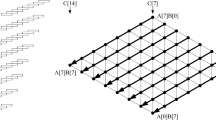Abstract
The importance of efficient multi-exponentiation algorithms in a large spectrum of cryptographic applications continues to grow. Previous literature on the subject pays attention exclusively on the minimization of the number of modular multiplications. However, a small reduction of the multiplicative complexity can be easily overshadowed by other figures of merit. In this article, we demonstrate that the most efficient algorithm for computing multi-exponentiation changes if considering execution time instead of number of multi-exponentiations. We focus our work on two algorithms that perform best under the number of multi-exponentiation metric and show that some side operations affect their theoretical ranking. We provide this analysis on different hardware, such as Intel Core and ARM CPUs and the two latest generations of Raspberry Pis, to show how the machine chosen affects the execution time of multi-exponentiation.






Similar content being viewed by others
References
Attias, V., Vigneri, L., Dimitrov, V.: Implementation study of two verifiable delay functions. In: Tokenomics, 6, pp. 1–6 (2020)
Barrett, P.: Implementing the Rivest Shamir and Adleman public key encryption algorithm on a standard digital signal processor. In: Lecture Notes in Computer Science (including subseries Lecture Notes in Artificial Intelligence and Lecture Notes in Bioinformatics), vol. 263 LNCS (1987). https://doi.org/10.1007/3-540-47721-7_24
Blondel, V.D., Tsitsiklis, J.N.: When is a pair of matrices mortal? Inf. Process. Lett. (1997). https://doi.org/10.1016/s0020-0190(97)00123-3
Blum, T., Paar, C.: Montgomery modular exponentiation on reconfigurable hardware. Proc.: Symp. Comput. Arith. (1999). https://doi.org/10.1109/arith.1999.762831
Borges, F., Lara, P., Portugal, R.: Parallel algorithms for modular multi-exponentiation. Appl. Math. Comput. 292, 406–416 (2017). https://doi.org/10.1016/j.amc.2016.07.036
Bosselaers, A., Govaerts, R., Vandewalle, J.: Comparison of three modular reduction functions. In: Lecture Notes in Computer Science (including subseries Lecture Notes in Artificial Intelligence and Lecture Notes in Bioinformatics), vol. 773 LNCS (1994). https://doi.org/10.1007/3-540-48329-2_16
Brent, R., Zimmermann, P.: Modern Computer Arithmetic. Cambridge University Press, Cambridge (2010). https://doi.org/10.1017/cbo9780511921698
Chang, C.C., Lou, D.C.: Parallel computation of the multi-exponentiation for cryptosystems. Int. J. Comput. Math. 63, 1–2 (1997). https://doi.org/10.1080/00207169708804548
Chang, C.C., Lou, D.C.: Fast parallel computation of multi-exponentiation for public key cryptosystems. In: Parallel and Distributed Computing, Applications and Technologies, PDCAT Proceedings (2003). https://doi.org/10.1109/pdcat.2003.1236459
Dimitrov, V.S., Jullien, G.A., Miller, W.C.: An algorithm for modular exponentiation. Inf. Process. Lett. 66(3), 155–159 (1998)
Dimitrov, V.S., Jullien, G.A., Miller, W.C.: Complexity and fast algorithms for multiexponentiations. IEEE Trans. Comput. 49(2), 141–147 (2000)
Euclid: The Elements of Euclid, 2nd edn. Dover Publications Inc., New York, USA (1956)
Gueron, S.: Efficient software implementations of modular exponentiation. J. Cryptogr. Eng. (2012). https://doi.org/10.1007/s13389-012-0031-5
Koç, Ç.K.: Montgomery Arithmetic, pp. 799–803. Springer, Boston (2011). https://doi.org/10.1007/978-1-4419-5906-5_38
Kochergin, V.V.: On Bellman’s and Knuth’s problems and their generalizations. J. Math. Sci. (U. S.) (2018). https://doi.org/10.1007/s10958-018-3928-4
Lou, D.C., Chang, C.C.: An efficient divide-and-conquer technique for parallel computation of modular multi-exponentiation. Comput. Syst. Sci. Eng. 15(2), 111–117 (2000)
Möller, B.: Algorithms for multi-exponentiation. In: Vaudenay, S., Youssef, A.M. (eds.) Selected Areas in Cryptography, vol. 2259, pp. 165–180. Springer, Berlin, Heidelberg (2001). https://doi.org/10.1007/3-540-45537-x_13
Montgomery, P.L.: Modular multiplication without trial division. Math. Comput. 44(170), 519–521 (1985)
Rivest, R.L., Shamir, A., Adleman, L.: A method for obtaining digital signatures and public-key cryptosystems. Commun. ACM 21(2), 120–126 (1978). https://doi.org/10.1145/359340.359342
Avanzi, R.M.: The complexity of certain multi-exponentiation techniques in cryptography. J. Cryptol. 18(4), 357–373 (2005). https://doi.org/10.1007/00145-004-0229-5
Van Meter, R., Itoh, K.M.: Fast quantum modular exponentiation. Phys. Rev. A: At., Mol., Opt. Phys. (2005). https://doi.org/10.1103/PhysRevA.71.052320
Wang, B., Hu, Y.: Signature scheme using the root extraction problem on quaternions. J. Appl. Math. (2014). https://doi.org/10.1155/2014/819182
Wesolowski, B.: Efficient verifiable delay functions. In: Ishai, Yuval, Rijmen, Vincent (eds.) Advances in Cryptology – EUROCRYPT 2019, vol. 11478 LNCS, pp. 379–407. Springer International Publishing (2019). https://doi.org/10.1007/978-3-030-17659-4_13
Yagisawa, M.: A digital signature using multivariate functions on quaternion ring. IACR Cryptol. ePrint Arch. 2010(2), 352 (2010)
Yen, S.M., Laih, C.S., Lenstra, A.K.: Multi-exponentiation. IEE Proc.: Comput. Digit. Tech. 141(6), 325–326 (1994)
Acknowledgements
We would like to thank some people that helped elaborating this paper. First, we would like to thank Prof. Paul Zimmermann from Loria, France, who took a lot of time to help us understand how multi-precision libraries work. Then, Colin Walter who clarified a lot of details on Montgomery reduction implementation. Thank you also to Wolfgang Welz from the IOTA Foundation for his engineering advises that helped us define the scope of this paper. Finally, thank you to Ilan Zajtmann for lending us some computation time on his Apple M1 computer to help us include cutting-edge technology in this survey.
Author information
Authors and Affiliations
Corresponding author
Additional information
Publisher's Note
Springer Nature remains neutral with regard to jurisdictional claims in published maps and institutional affiliations.
Rights and permissions
About this article
Cite this article
Attias, V., Vigneri, L. & Dimitrov, V. Rethinking modular multi-exponentiation in real-world applications. J Cryptogr Eng 13, 57–70 (2023). https://doi.org/10.1007/s13389-022-00287-w
Received:
Accepted:
Published:
Issue Date:
DOI: https://doi.org/10.1007/s13389-022-00287-w




